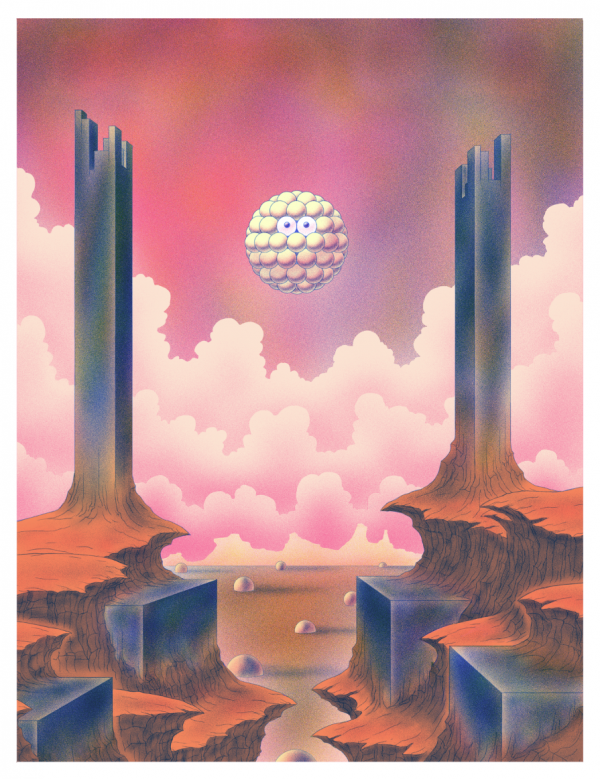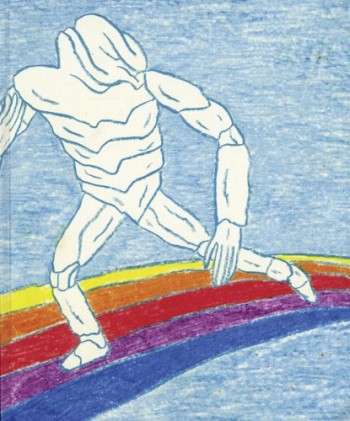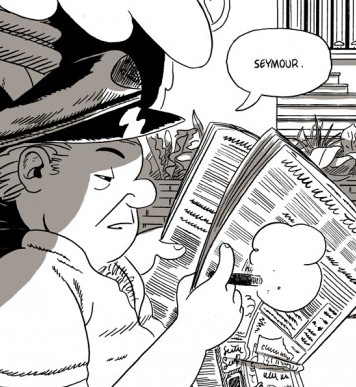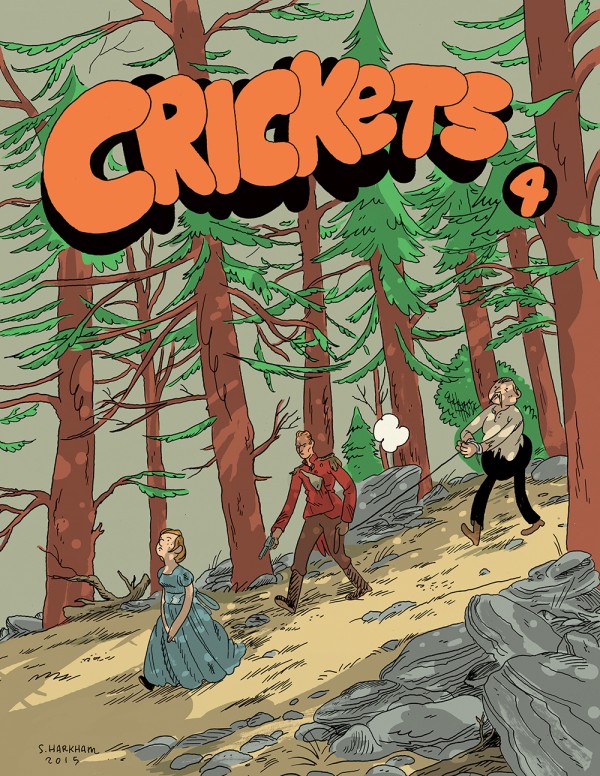
July 9, 2015
 CR Newsmaker Interview: Sammy Harkham, On The Announcement Of Kramers Ergot Vol. 9
CR Newsmaker Interview: Sammy Harkham, On The Announcement Of Kramers Ergot Vol. 9


*****

I met the cartoonist and editor Sammy Harkham at a
Comic-Con International either late in the period of my working at
Fantagraphics or just after. I was younger then; Harkham was legitimately young. His
Kramers Ergot series was on its first or second issue then. When the fourth volume of the anthology dropped in 2003, it was one of the stand up and notice moments that comics wasn't going to let the previous decade's industry-driven frustrations rob the art form of its momentum. Thoughtful and consistently of a high quality on the page,
Kramers has gone on to become what many feel is the signature anthology of its time, reaching its buzz apex with volume 7, the famously tabloid-sized issue.
A discussion of potential covers and an Amazon.com listing have let it slip that a ninth volume of
Kramers is imminent, with Fantagraphics as its publisher. I could not be happier to talk to Harkham about this major life's work of his -- and a bit about his own comic,
Crickets, which this year saw a very strong fourth issue -- on Comic-Con weekend, the coverage of which sometimes strays a bit far from comics for my taste despite the con remaining a very effective comics show.
I exchanged e-mails with Harkham and then tweaked the result for flow. -- Tom Spurgeon
*****
TOM SPURGEON: This is a pretty standard interview question, but did you have any idea when you started that you might still be doing this anthology? Did you have that kind of ambition for it?
SAMMY HARKHAM: I like making
Kramers Ergot, so despite whatever difficulties faced from issue to issue, I realized a couple years ago I would like to keep doing them for awhile. I think what evolves are the methods. I want to spend my creative time on my own strip. And I know my strip gets shortchanged when doing an issue of
Kramers. So I changed the methods. Previous
Kramers were put together by asking a specific group of artists to contribute and then working with the individual artist on what that would be. For one artist that might mean a 24 page story. For another it might mean a series of one pagers and sketchbook pages, etc. Then I spend up to a year just keeping track of people and seeing how it all fits. I didn't heavily edit, and only occasionally rejected stuff. I made sure to just ask the right people.
After #8, I decided to treat
Kramers Ergot like a magazine: so a (fairly) open submission policy, the right to reject stuff, the right to edit material. It was no accident that RAW was so good and holds up so well and it did things very much in that way. And there were benefits this way: 1)I could ask a wider group of people, so the chances of getting something great from someone I barely was aware of but intrigued by were much higher. 2) I didn't need to chase people down and remind them of deadlines, since I wasn't waiting on any one person and would only work with what arrived. 3) I could treat it like a hobby for two years and only work on it like a gardening project and could focus more attention on my own comics. 4) While there was a deadline for the specific issue, I made clear to potential contributors that the submission door is always open. That means work will hopefully always be coming in and
Kramers can come out whenever a new issue is ready, which is hopefully more frequent. 5) I think its good for cartoonists to have as many options as possible as to where to send work for publication, especially short stories.
Kramers is now one more place.
 SPURGEON: Was there a moment during
SPURGEON: Was there a moment during Kramers' publishing history during which you kind of knew you were onto something special, something that at least within the small world of comics was unique and memorable? I and some other close watchers of the comics industry remember the release of Vol. 4 as being something of an event.
HARKHAM: Yeah, I don't know about that. I think there are great comics and great cartoonists out there and it is exciting to create a context since none really exists, or the ones that do exist I feel no kinship with. If you do that well, it's a bit magical because you are making aesthetic and philosophical connections between disparate work, and an undefinable feeling emerges, creating a whole better then the parts.
Kramers 4 was a good issue, as it was mostly led by the nose. And I didn’t bite off more then I could chew in the design and layout of the book. I think the big visual inspiration was Kim Hiorthoy’s first monograph, where it felt very very matter of fact and tactile and that book gave me the inspiration to leave out things I didn’t feel I understood well, things like page numbers, typography, introduction/editor notes, and mechanical design. In exchange, I had the content pages drawn as comics, the cover ran without a title, and there was no copy on it or in it beyond the bare essentials. That felt right because I was working within my means. It aimed low. but the majority of the work was good and there was a lot of it, and all that together probably resulted in a fun book for the reader.
SPURGEON: Would you agree that you've become more interested in shaping a specific kind of reading experience as the series has progressed? I think that was a hugely underrated aspect of the last one, the way the presentation kind of dictated how the work was received, and even what work went in there. Is that presence something we continue to see in Vol. 9?
HARKHAM: Yes. More than ever I think its important to let the work dictate the overall form and feeling of the object. Since I asked so many people to consider submitting, I didn't let myself think about what the finished book will be. I wanted to make those decisions once I had enough work submitted and accepted. It was super hard even just coming up with a page size to give to potential contributors, but I opted for 9 x 11.75 because that seems like an optimal reading and looking size up to 300 pages, and could be good as hardcover or softcover. Once the majority of the guts were locked, I could start looking at it and thinking about what all this feels like and how it should be presented (hardcover? soft? dust-jacket?edge tinting? etc.).
The last two issues of
Kramers were formed with a format ideas at the outset -- with number 7, it was to do something at 16x21, in the tradition of old newspaper comics and with number 8 it was to do something pretty cold and angry and somewhat almost generic. They were both hard books to edit since it was about finding work to fit into a preconceived mold. Strangely, the great work I got for this new issue all felt aligned in some way, so the job, at its most basic, is to forefront that through the order of the stories and the design of the book.
SPURGEON: Do you have any thoughts about the changing context in which Kramers
has been published? It used to be that anthologies were galvanizing documents for a specific generation or group of cartoonists, but that this was then underlined by watching individual artists make their own way and make their own comics... I get a less a sense of this now, and in fact there are many, many more anthologies now. What role does Kramers
have and do anthologies have in terms of the overall marketplace, do you think? Could we use more anthologies? Fewer?
HARKHAM: The short answer is I think an anthology of quality is a great thing unto itself and that comics are a wonderful short form.
But the long answer is I think I look at anthologies a little differently than you. I love how they age as these great time capsules of a moment and sensibility and often of a region. I never really looked at anthologies as launching grounds for careers, but maybe you mean as avenues to discover work, which I agree with. I love the history and tradition of cartooning and looking at anthologies made in the past I am most struck by a beautiful sense of what cartooning is, as a medium. And
Kramers Ergot is very much made in the spirit of that, to gather what I think is beautiful in comics past and present and gather it all together and present it well and say, "This is what we are today." To create a good context for them so the reader can engage it in the best possible way.
One of the more exciting things about an anthology is the context it creates. It contextualizes what all this stuff is within the wider culture. I think the last issue of
Mould Map was absolutely stunning in this way. I think bad anthologies are bad not necessarily because of the work they include but how they present it. They do a disservice to the cartoonists by obscuring and muddling up their work with bad decisions. I don't relate to much of comics wider culture or the subcultures its often linked to -- illustration, pop culture, animation -- but at the same time I relate very much to the history and variety of the medium. It's my bread and butter.
Kramers Ergot is my continual attempt at creating a context that makes sense to me. And that's maybe a better answer to your earlier question about continuing to make these books. It's because of a profound love of the medium and I don't see that going away.
As to marketplace, if you mean economically,
Kramers Ergot would not exist from that angle. it doesn't make enough money for anyone to justify its production. but like most of publishing, which is not lucrative, its still useful and necessary. I also don't think I agree with you that there are a lot of anthologies. maybe so, but few of quality. I am eagerly looking forward to Brandon Graham's
Island. there are comics on the internet, but the internet is contextless. It's an ocean.
And lastly on "why," I am very much interested in figuring out a model to pay cartoonists a respectable page rate to do their work. it feels like the time is right for a non genre based semi-regular comics anthology to come out to the news stands. raw was on the way to being that, but Art and Francoise are bigger and better than that and couldn't be contained. Hopefully, soon, I will have figured it out. I think it is really necessary.
 SPURGEON: You told me something in Portland that you and some of your peers in comics might have overthought how best to make comics, and that maybe it's still all about just completing work and getting it out there on a regular basis. Is that a fair encapsulation of your view? Can you course-correct, is there an element with
SPURGEON: You told me something in Portland that you and some of your peers in comics might have overthought how best to make comics, and that maybe it's still all about just completing work and getting it out there on a regular basis. Is that a fair encapsulation of your view? Can you course-correct, is there an element with Crickets
and with this new KE
volume of just getting to work?
HARKHAM: Yes thats about it. I talk to cartoonists and you get a sense of scrambling to figure out ways to make it work, financially, once they seem to have developed a fairly good sized readership, a solid publisher, and some positive "buzz." It seems the best you can do, the best combination you can hope for starting out, is to be able to do work of high quality fast. If you can do that, you have a chance in comics. Most are either too slow, or they release a lot of work but of middling quality.
I am genuinely in awe of anybody in the comics industry who makes their living from making comics. That's a wonderful thing. What I think the rest of us do, is at a certain point, you begin to scramble and to find ways to make it work I need an - agent! I need to do a topical graphic novel! A memoir! I need to do a web comic! But once you exhaust yourself thinking about what you did wrong, what could you do better, it really is about producing the work and just releasing it, and trusting that it will find whatever audience there is for it, naturally. You can't look at the success of another cartoonist and assume you can copy it. So therefore, just do the work and things fall where they fall.
You can look at a successful non-genre cartoonist, like Chris Ware, and it's as simple as it gets as far as a "plan." He drew
Jimmy Corrigan one page a week -- it ran in weekly papers. When he had enough material for a comic book, it came out as a comic. Then when it was all done it came out as a book. I think thats as good a model as any, with the web being the equivalent of the weekly paper.
So I don't think cartoonists should worry about finding a way. If anything, they have a tendency to get in their own ways and make things incredibly complicated. Very few people will have the readership of Ware, so I am not taking about making a living now, I am talking about a system to keep engaged and working on comics. I am tempted to think cartoonists are like fiction writers, who also rarely make a real living from their work, but there is institutional support in the other arts thats are not in place in comics. People love the story of carver sitting in his driveway writing at his dashboard after work, but it's not true. Talented writers are often recognized and encouraged and supported very early on. The more of that in comics the better. Until then, I think its healthy to expect nothing, do it because you love the process, the medium, and the great people it puts you in contact with. That's enough.
SPURGEON: The fact that I saw you at one of the 18 billion shows we have in a year makes me wonder if you had any thoughts about all of those conventions. You certainly have benefited by being able to debut work to a roomful peers, but is there too much of a good thing? Are we asking cons to step in for a kind of distribution and day to day industry that just doesn't exist?
HARKHAM: No, they are fine, they contribute positively to the overall industry. They build community and relationships and that's important for a lot of people unto itself and maybe, just maybe, that could lead to financial opportunities as well. I had a revelation a couple years ago at HeroesCon in North Carolina, where I loved walking around the show, and looking at old comics and fanzines and watching guys like Kevin Nowlan and Brian Bolland draw commissions for customers, but at the same time I also made no money as an exhibitor. And i realized that just because I love a certain subculture -- in this case comics fandom circa 1978 -- it doesn't mean they will love me back. And vice versa. as I said earlier, I don't relate to any of the current comics cultures, so shows are not superimportant to me or my process. But I think they are important for many artists, where they do relate to the other work being exhibited and the general vibe of those scenes.
SPURGEON: Fantagraphics isn't a new player. What does that company do right now, what role do they play and what do they bring to the table, that makes them an attractive partner for you on this?
HARKHAM: I think about Kim Thompson every day, and I don't know what Fantagraphics is now without him, so there is an unknowable element with working with them. Obviously, my identity and life path was completely formed by the company as a reader in the mid-'90s, between
The Comics Journal, the new comics they published, and the reprints.

I am friends with Eric Reynolds but we hadn't worked together 'til Josh Simmons'
Black River book, which I designed. He was very open to exploring whatever notions we had on that project. it was after that that I thought maybe Fantagraphics would be ideal partners for
Kramers. They are at this point a well-oiled machine in regards to promotion and distribution, and I am intrigued by using that machine for a book like
Kramers. And they give their authors creative control (often too much control I think!).
I spent over a year considered my options, and I think Fanta offers the best of all worlds. Doing the book with an art book publisher had certain benefits, but they wouldn't sell more copies and it would annoy me the book would be in the art section of the stores. I considered self-publishing it since thats the best bet to pay good page rates, since I would hand sell the majority of them. But a friend made a nice point that
Kramers has a wide readership and self publishing would only narrow that, and in this current climate of Kickstarter where people forgo the casual browser and instead focus on maximizing dollars out of the core fan base, that seemed wrong.
Kramers Ergot has never been published by a company as big as Fantagraphics, so I am excited to work with them and see what we can do. I also feel very comfortable positioning the anthology within the Fantagraphics family, as I love their history, and think they are the best comics publisher in the world right now.
SPURGEON: How long can you continue to do Kramers
? How do you mark their effectiveness, the differences between volumes? If this one works, do you have a hunch as to why that will be? How do you even measure the success of a book like this one?
HARKHAM: Man, all these questions are big questions. [Spurgeon laughs]
I will continue to do
Kramers as long as I am interested in comics. There is always work, older stuff that is out of print or new stuff you feel isn't getting just due that you want to stand behind. It's a good side project for me. The frustrating thing with editing an anthology is you are only as good as the contributions. So I ask 60-80 cartoonists to contribute and I work with what I got. There are people, Shary Flenniken for example, who I call every year and reject me every year. I start with a huge list of ideas and it morphs and shifts with what I can get in the time frame we have. I just try to make it as good as possible.
If it works, its because people trusted me and sent me great work and I delegated right. I measure the success of a book like this by copies sold and when I finally look at it for the first time in a couple years and it works for me at that remove.
*****
*
Kramers Ergot Vol. 9, Edited By Sammy Harkham, Fantagraphics Books, softcover, 250 pages, March 2016, $45.
*****
* cover to
KE Vol. 9
* photo of Harkham by Whit Spurgeon, 2009, at HeroesCon
*
KE Vol. 4
* image from
Crickets #4
* the
Black River book Harkham designed
* cover to
Crickets #4 (below)
*****

*****
*****
posted 7:00 pm PST |
Permalink
Daily Blog Archives
November 2019
October 2019
September 2019
August 2019
July 2019
Full Archives


